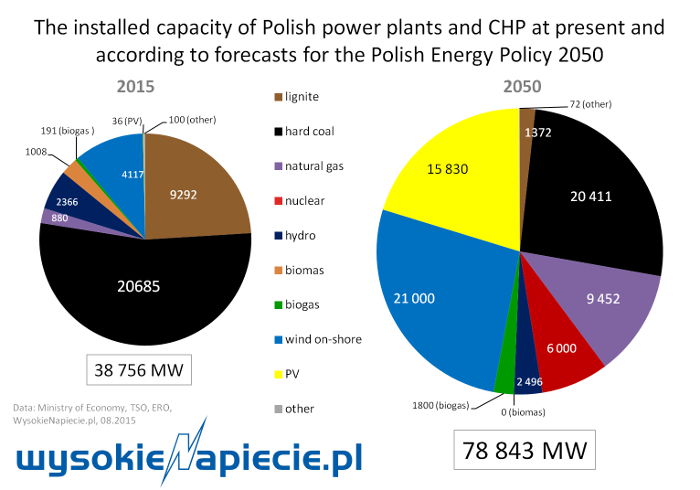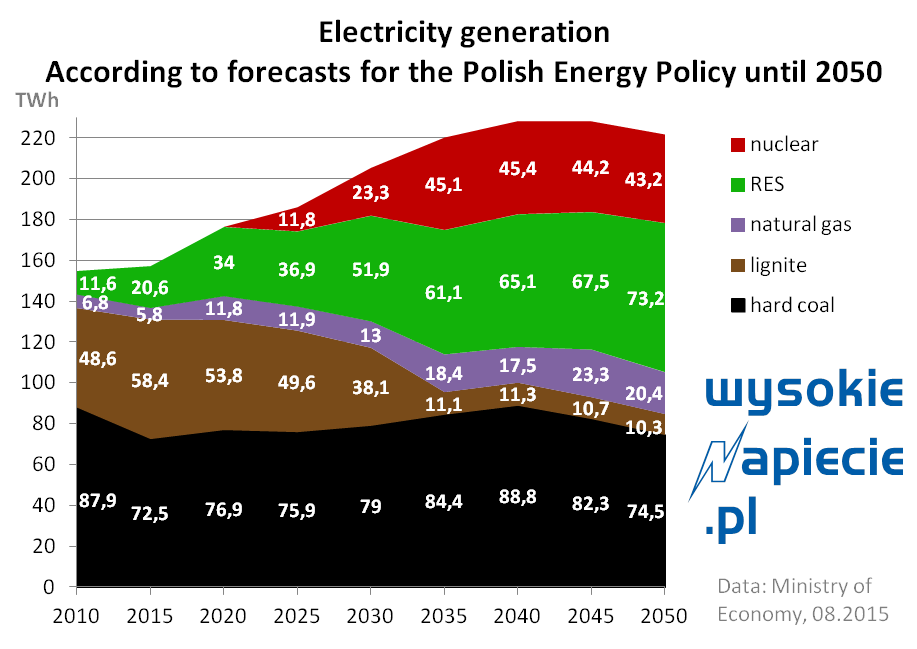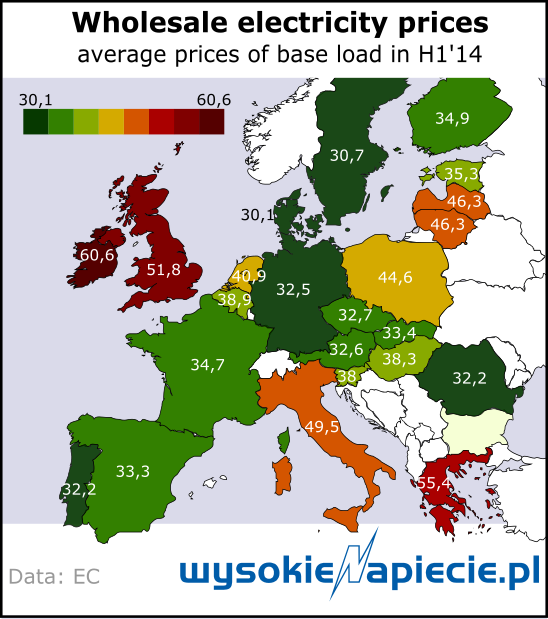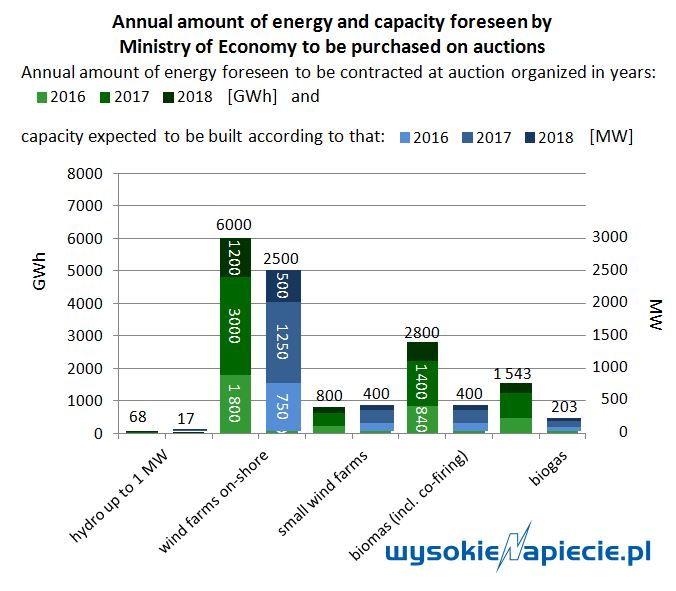Despite the provisions on the key share of lignite and hard coal in the energy mix, Poland will continue to increase the share of renewables also after 2020. To what extent – that is yet to be determined as haggling over the exact target share of renewables is still underway. Below, we present concepts that have been discussed by the governmental teams as well as the forecasts commissioned by the Economy Ministry.
 Poland’s government has decided that the share of energy from renewable sources in the end consumption (of electricity, heat and fuels) will have to grow also after 2020, a direction previously opposed by the cabinet led by Donald Tusk (which, in turn, was against Poland’s current Energy Policy until 2030). The factor that tipped the scales in favor of this new approach was the adoption of the EU climate and energy package for 2021-2030 where the EU set a renewables target for the whole block at 27% by end-2030.
Poland’s government has decided that the share of energy from renewable sources in the end consumption (of electricity, heat and fuels) will have to grow also after 2020, a direction previously opposed by the cabinet led by Donald Tusk (which, in turn, was against Poland’s current Energy Policy until 2030). The factor that tipped the scales in favor of this new approach was the adoption of the EU climate and energy package for 2021-2030 where the EU set a renewables target for the whole block at 27% by end-2030.
Also on WysokieNapiecie.pl: Polish RES auctions only in 2016-2018?
{norelated}The EU member states are to submit to the European Commission the information on their contributions to the realization of the joint target. Based on these forecasts, the EC will calculate whether the proposed contributions will suffice, or if it should ask that certain states step up their efforts.
 What will Poland’s proposal look like? According to the information of energy legislation information service Obserwator Legislacji Energetycznej, Poland will pledge a renewables share of at least 20% in gross end-consumption of energy (as compared to the Polish target by 2020 of 15%). But at the Economy Ministry some voices can be heard calling for a greater engagement in the green energy – there has even been a proposal to set the target share by 2030 at 27%. Still, this would eliminate a substantial quantity of coal from consumption and hence enforce more coal mine closures in the coal industry region Silesia, an option unacceptable to either the ministry, or the government.
What will Poland’s proposal look like? According to the information of energy legislation information service Obserwator Legislacji Energetycznej, Poland will pledge a renewables share of at least 20% in gross end-consumption of energy (as compared to the Polish target by 2020 of 15%). But at the Economy Ministry some voices can be heard calling for a greater engagement in the green energy – there has even been a proposal to set the target share by 2030 at 27%. Still, this would eliminate a substantial quantity of coal from consumption and hence enforce more coal mine closures in the coal industry region Silesia, an option unacceptable to either the ministry, or the government.
At the inter-ministerial team for energy policy, perplexity arose at the mere comparison illustrating that a renewables share increase to 22% would be tantamount to eliminating a power plant of the size of the Belchatow facility – and would take a toll also on the results of state-run power companies.
 Nevertheless, the ministry took a flexible approach concerning the issue. For the purposes of “fuel and energy needs forecast until 2050” commissioned by the ministry from the Polish National Energy Conservation Agency (KAPE), the ministry officials set only a lower limit of 20% renewables share. According to our information, the same assumption was adopted for the purposes of this forecast revision currently prepared by think-tank WISE (both analyses are based on the same engine of WISE).
Nevertheless, the ministry took a flexible approach concerning the issue. For the purposes of “fuel and energy needs forecast until 2050” commissioned by the ministry from the Polish National Energy Conservation Agency (KAPE), the ministry officials set only a lower limit of 20% renewables share. According to our information, the same assumption was adopted for the purposes of this forecast revision currently prepared by think-tank WISE (both analyses are based on the same engine of WISE).
The results may come as a surprise: the KAPE forecast shows an increase in renewables share in electricity production from the currently planned 19.3% in 2020 (30 TWh/year) to 25% in 2030 (nearly 52 TWh/year) and to nearly 33% by 2050 (over 73 TWh/year).
Still, one should not hope for any significant changes as a result of the revision of the forecast for the Polish energy policy PEP 2050, an insider working on the forecast tells us. The Economy Ministry will thus probably end up with a similar energy mix. According to our findings, the ministry might yet adjust it, but the changes are unlikely to be significant.
Also on WysokieNapiecie.pl: President Duda – little promise of change for energy policy lines
As a result, the share of renewable energy will exceed that of lignite-based power as soon as by the end of the next decade. And in 2050, it will almost catch up with hard coal-based energy.
Read more: Is Polish coal doomed to extinction?








 Opposing climate policy, defending coal industry employees and diversifying natural gas supplies – these are political declarations of Poland's president-elect. Then there are also the declarations of Duda’a party PiS to consider: tilting at windmills, poor support for Poland’s nuclear power plant and for prosumer energy sector. The new president stands for the continuation along the lines of energy policy of PO-PSL government.
Opposing climate policy, defending coal industry employees and diversifying natural gas supplies – these are political declarations of Poland's president-elect. Then there are also the declarations of Duda’a party PiS to consider: tilting at windmills, poor support for Poland’s nuclear power plant and for prosumer energy sector. The new president stands for the continuation along the lines of energy policy of PO-PSL government. I know that changes in Poland will be painful in the short term, but it’s better to prepare the ground for them already. It’s important to learn from other countries’ experiences - says Philip Garner, Director General of Coal Pro, the confederation of UK coal producers in an interview on what went wrong in the UK's coal mining sector and what can happen in Poland.
I know that changes in Poland will be painful in the short term, but it’s better to prepare the ground for them already. It’s important to learn from other countries’ experiences - says Philip Garner, Director General of Coal Pro, the confederation of UK coal producers in an interview on what went wrong in the UK's coal mining sector and what can happen in Poland. The Ministry of Economy of the Republic of Poland estimates that renewable energy auctions will take place only in the period between year 2016 and 2018. Investors can expect energy sales at 320-470 PLN per MWh. But the auctions may not be organized for everyone - according to information obtained by the Energy Legislation Observer of the WysokieNapiecie.pl website.
The Ministry of Economy of the Republic of Poland estimates that renewable energy auctions will take place only in the period between year 2016 and 2018. Investors can expect energy sales at 320-470 PLN per MWh. But the auctions may not be organized for everyone - according to information obtained by the Energy Legislation Observer of the WysokieNapiecie.pl website.